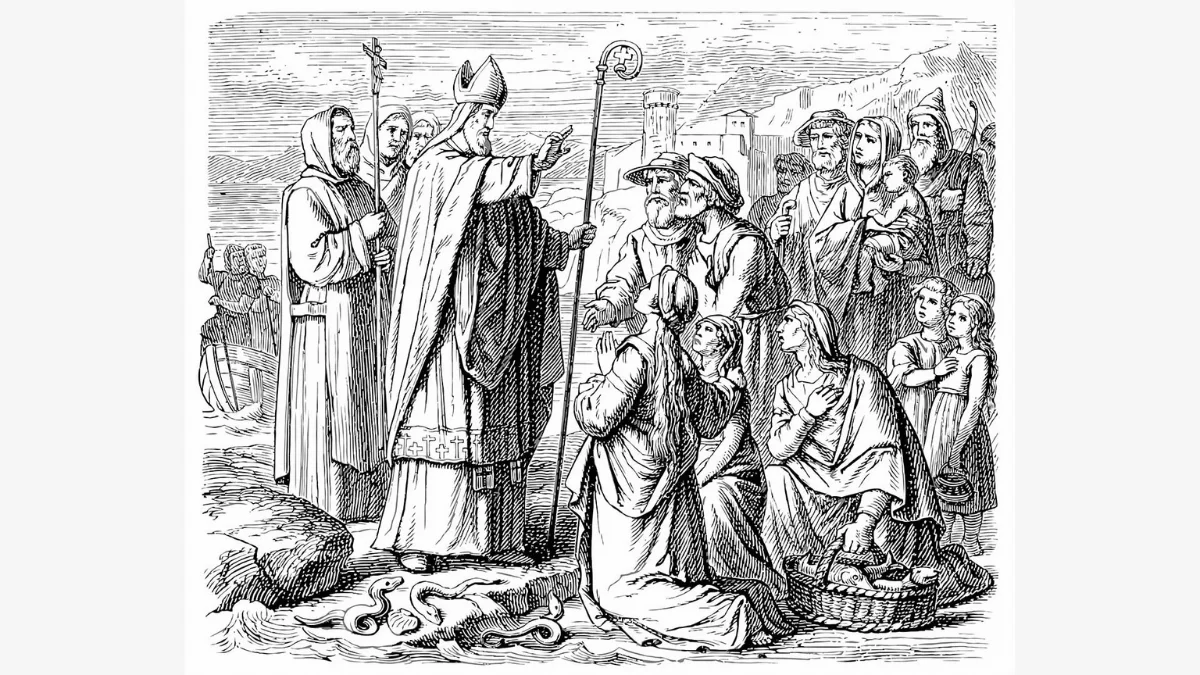Who is Saint Patrick?
Saint Patrick, the patron saint of Ireland, is one of Christianity’s most widely known figures. But for all his celebrity, his life remains somewhat of a mystery. Many of the stories traditionally associated with Saint Patrick, including the famous account of his banishing all the snakes from Ireland, are likely to be apocryphal, the products of hundreds of years of exaggerated storytelling.
The Purpose of This Blog Post
Turning to the truth, it becomes necessary to examine the life of Saint Patrick. Who was he? How did he live his life? And, most importantly, how did he die? This blog post aims to explore these questions, delving into the historical records and shedding light on the life and death of this fascinating figure.
Why Learn About Saint Patrick?
Understanding the life and death of Saint Patrick is not just an exercise in history. It’s about understanding the man behind the legend, the human being behind the saint. It’s about appreciating the struggles and triumphs of a man who lived centuries ago, and yet continues to impact millions of lives today.
What to Expect?
We will explore Saint Patrick’s early life, his mission in Ireland, the circumstances of his death, and his enduring legacy. Each section will provide a detailed examination of different aspects of Saint Patrick’s life and death, offering a comprehensive understanding of this significant historical figure.

The Circumstances of Saint Patrick’s Death
Details about His Death Based on Historical Records
Saint Patrick is believed to have died on March 17, around the year 461 AD. The exact circumstances of his death are not known, as there are few historical records from this time. However, it is generally accepted that he died in Saul, where he had built his first church in Ireland.
Common Myths and Misconceptions
There are many legends associated with Saint Patrick, and his death is no exception. One common myth is that he lived to be over 100 years old. While this is possible, it’s unlikely given the average life expectancy of the time.
Another legend is that he was buried in Downpatrick, Ireland, alongside Saint Brigid and Saint Columba. However, this is disputed by historians, and the exact location of his grave remains a mystery.
Facts vs Myths about Saint Patrick’s Death
| Fact or Myth | Description |
| Fact | Died on March 17, around 461 AD |
| Fact | Died in Saul, Ireland |
| Myth | Lived to be over 100 years old |
| Myth | Buried in Downpatrick, Ireland, alongside Saint Brigid and Saint Columba |
Understanding the circumstances of Saint Patrick’s death helps us separate fact from fiction and gain a clearer picture of his life. In the next sections, we will explore his early life, mission in Ireland, and enduring legacy.
Early Life of Saint Patrick
Birth and Early Years
Saint Patrick, whose birth name was Maewyn Succat, was born in Roman Britain in the late 4th century, around 385 AD. His father was a deacon and his grandfather a priest in the Christian church, indicating a strong religious influence in his early life. However, Patrick himself was not particularly religious as a child.
Journey to Sainthood
At the age of 16, Patrick was captured by Irish pirates and taken as a slave to Ireland. He spent six years there, working as a shepherd. During this time, he turned to his faith for solace. He grew increasingly devout and began to dream of converting the Irish to Christianity.
Patrick eventually escaped from slavery and returned to his family in Britain. But he felt a calling to return to Ireland. After studying and becoming ordained as a priest, he went back to the land of his captivity. He took the Latin name Patricius, or Patrick, which means “father figure,” when he became a priest.
Key Events in Saint Patrick’s Early Life
| Event | Year | Description |
| Birth | 385 AD | Born in Roman Britain |
| Captured by Irish pirates | 401 AD | Taken as a slave to Ireland |
| Escape from slavery | 407 AD | Returned to his family in Britain |
| Ordained as a priest | 432 AD | Took the name Patricius and returned to Ireland |
Saint Patrick’s Mission in Ireland
His Work and Achievements in Ireland
After returning to Ireland, Saint Patrick embarked on a mission to convert the Irish to Christianity. He traveled across the country, preaching the Gospel, building churches, and baptizing new believers. Despite facing numerous challenges, including opposition from local chieftains, he remained steadfast in his mission.
Saint Patrick is credited with using the three-leaved shamrock to explain the concept of the Holy Trinity to the Irish people. This teaching method helped the largely pagan population understand the Christian belief of one God in three persons: the Father, the Son, and the Holy Spirit.
Impact on Irish Culture and Christianity
Saint Patrick’s mission had a profound impact on Ireland. He successfully converted a significant portion of the population to Christianity, which led to a decline in pagan practices. His influence extended beyond religion, as he also played a role in shaping Irish culture and society.
Saint Patrick’s work in Ireland also had a lasting impact on Christianity as a whole. He established monasteries, schools, and churches that would later become centers for learning and culture during the Dark Ages. His mission laid the groundwork for the spread of Christianity throughout Europe.
Significant Contributions of Saint Patrick in Ireland
| Contribution | Description |
| Preaching the Gospel | Traveled across Ireland, spreading the message of Christianity |
| Building Churches | Established numerous churches across the country |
| Baptizing Believers | Baptized thousands of new Christian believers |
| Using the Shamrock | Used the three-leaved shamrock to explain the Holy Trinity |
| Shaping Irish Culture | His teachings and practices influenced Irish culture and society |
Saint Patrick’s mission in Ireland was a monumental task that required immense faith, courage, and perseverance. His contributions continue to resonate in Ireland and beyond, making him a pivotal figure in the history of Christianity.
This period of Saint Patrick’s life laid the foundation for his later work and sainthood. His experiences, both as a captive and a priest, shaped his views and fueled his mission to spread Christianity in Ireland.
The Legacy of Saint Patrick
How His Death Was Commemorated
Saint Patrick’s death marked the end of an era, but it was just the beginning of his legacy. His death is commemorated every year on March 17th, known worldwide as Saint Patrick’s Day. This day is celebrated with parades, wearing of green attire, and public festivals. It’s a testament to the lasting impact of Saint Patrick that his death anniversary is celebrated with such joy and festivity.
His Influence on Modern Times
Saint Patrick’s influence extends far beyond the shores of Ireland. His life and teachings have left a lasting impact on the Christian world. He is revered as a saint in many Christian traditions, and his writings, particularly his “Confessio,” continue to be studied for their spiritual insights.
In Ireland, Saint Patrick is more than just a historical figure; he is a symbol of national pride and cultural identity. His legacy is evident in the country’s rich Christian heritage, its numerous churches and religious institutions, and the enduring popularity of Saint Patrick’s Day.
Saint Patrick’s Legacy in Numbers
| Legacy | Description |
| Saint Patrick’s Day | Celebrated worldwide every year on March 17 |
| Churches | Thousands of churches in Ireland owe their existence to Saint Patrick’s missionary work |
| “Confessio” | One of the few surviving writings of Saint Patrick, studied worldwide for its spiritual insights |
Saint Patrick’s life and death are a testament to the enduring power of faith and the human spirit. His legacy continues to inspire and influence people around the world, making him a truly timeless figure.
Conclusion
Recap of Saint Patrick’s Life and Death
We’ve journeyed through the life and death of Saint Patrick, from his early years in Roman Britain to his missionary work in Ireland, and finally, his death and enduring legacy. We’ve seen how he transformed from a slave into a saint, how he used a simple shamrock to explain complex theological concepts, and how his death led to a worldwide celebration.
Final Thoughts on His Lasting Impact
Saint Patrick’s life serves as a reminder of the power of faith and resilience. His teachings continue to inspire millions of people around the world, and his legacy lives on in the form of Saint Patrick’s Day celebrations, the shamrock symbol, and the Christian heritage of Ireland.
In exploring the life and death of Saint Patrick, we’ve not only learned about a significant historical figure but also gained insights into the rich cultural and religious history of Ireland. It’s a testament to Saint Patrick’s impact that, centuries after his death, we continue to celebrate his life and remember his contributions.
Thank you for joining us on this journey through the life and death of Saint Patrick. We hope you found this blog post informative and engaging. Remember, history is not just about the past; it’s about understanding our present through the lens of those who came before us.
After years of living in poverty, traveling and enduring much suffering he died March 17, 461. He died at Saul, where he had built the first church. Why a shamrock? Patrick used the shamrock to explain the Trinity, and has been associated with him and the Irish since that time.
The Death of St. Patrick, the apostle of Ireland. At the Monastery of Saul in Ulidia, March 17th A.D. 465, aged 78 years.
Saint Patrick was kidnapped from England at the age of 16 and sold into slavery in Ireland. He escaped after six years, only to return to convert Ireland to Christianity. The medieval saint continued to lead a dangerous life, as he came into conflict with local power-brokers.

